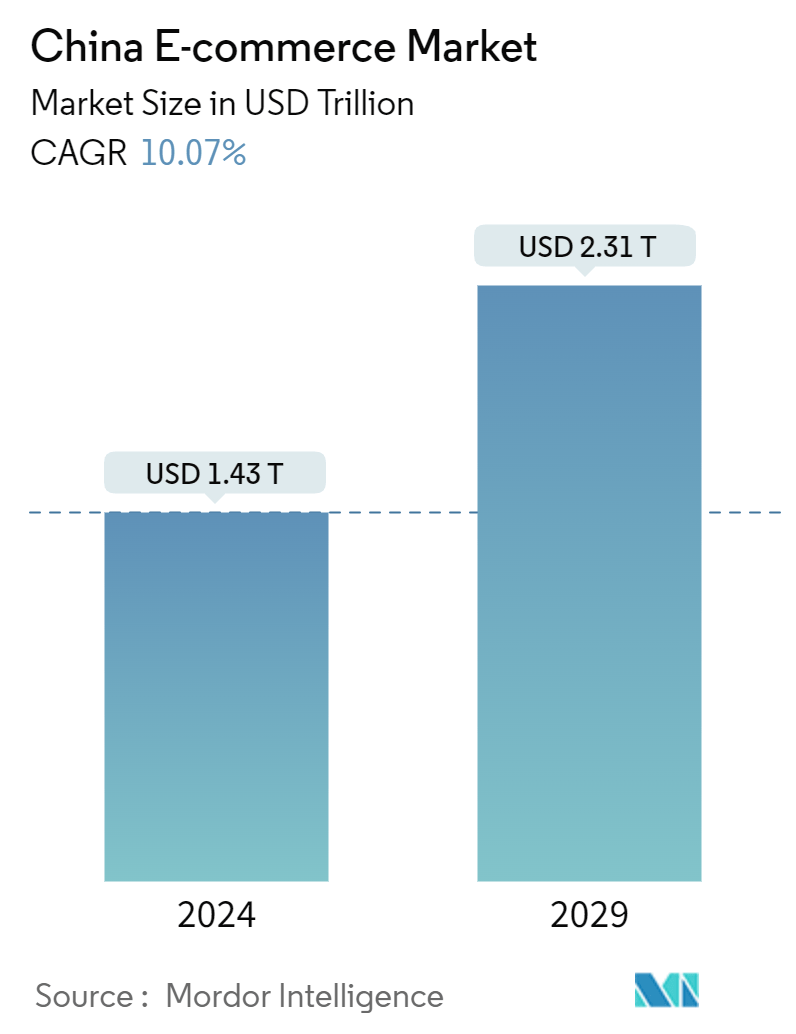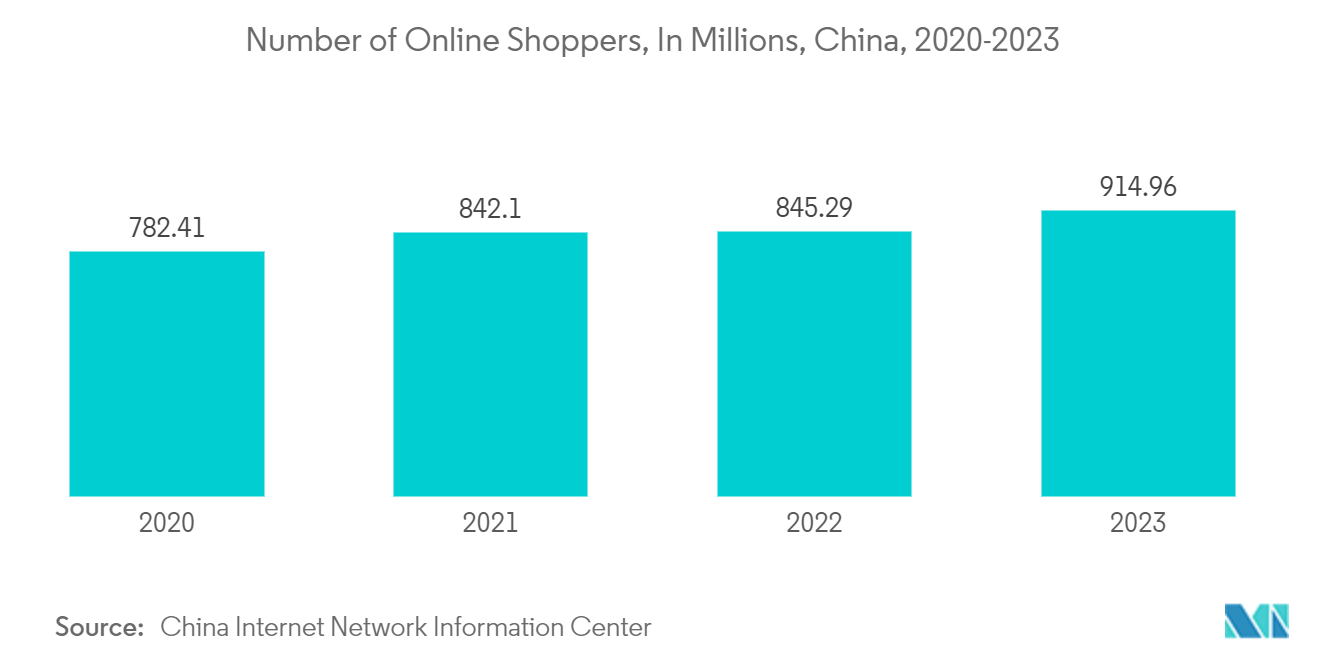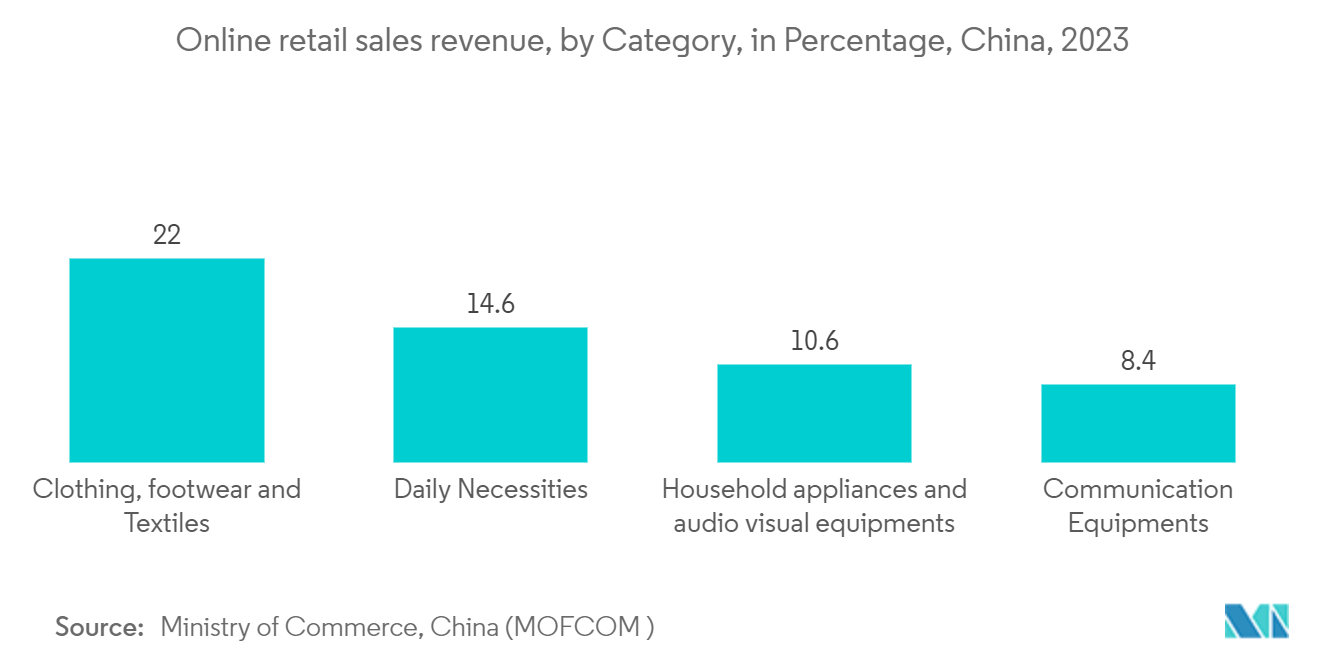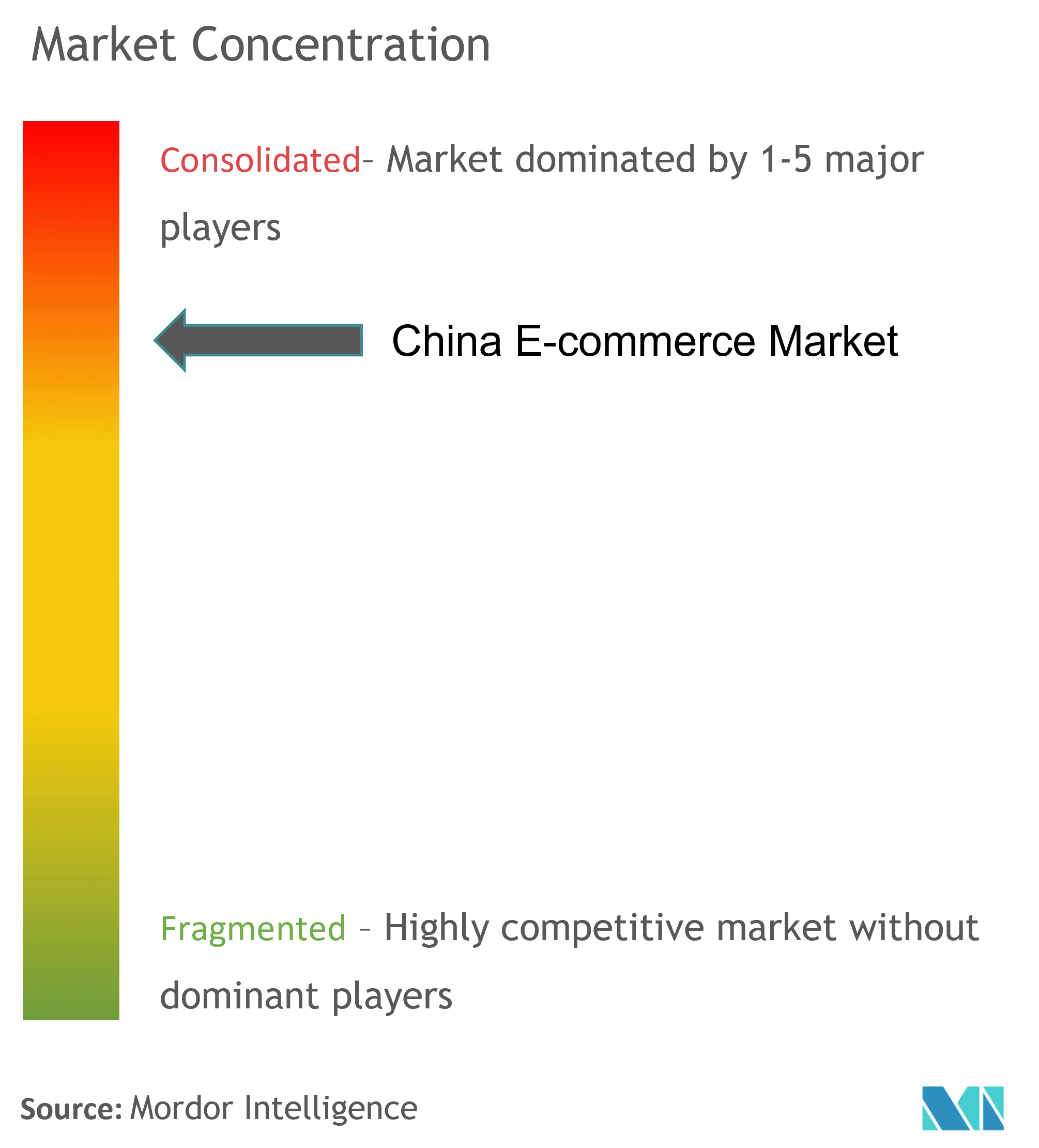China E-commerce Market Size

| Study Period | 2019 - 2029 |
| Base Year For Estimation | 2023 |
| Market Size (2024) | USD 1.43 Trillion |
| Market Size (2029) | USD 2.31 Trillion |
| CAGR (2024 - 2029) | 10.07 % |
| Market Concentration | High |
Major Players
*Disclaimer: Major Players sorted in no particular order |
China E-commerce Market Analysis
The China E-commerce Market size is estimated at USD 1.43 trillion in 2024, and is expected to reach USD 2.31 trillion by 2029, growing at a CAGR of 10.07% during the forecast period (2024-2029).
- The primary factors driving the growth of the e-commerce market in the region are smartphone-driven m-commerce culture, innovative digital payment systems, and rising live-commerce platforms, among others.
- With a vast population, the Chinese e-commerce market is the world's largest. The Chinese E-commerce market evolved rapidly during the past few years, primarily driven by high Internet and smartphone penetration, increased consumer confidence in online shopping, the emergence of e-commerce platforms, and various alternative payment solutions.
- Alternative payment solutions were the primary beneficiary of rising e-commerce purchases. Payment solutions such as Alipay and WeChat Pay are rapidly growing for e-commerce platforms. Alipay is a primary payment tool on all the e-commerce platforms owned by the Alibaba Group. On the other hand, WeChat Pay, which is offered by Tencent, leverages its massive social media user base to push online payments. As Chinese customers continue to embrace e-commerce, these payment solutions are expected to gain momentum.
- An inconvenient and often confrontational in-person shopping culture helped motivate shoppers in the region to embrace the straightforward reliability of e-commerce platforms. Also, they are easy to use in various shopping activities for making returns and securing refunds for online orders. Moreover, the low-cost delivery services provided by China's millions of migrant laborers enable companies like JD.com and Alibaba Group to provide same-day delivery anywhere in the country.
- While supportive policies exist, e-commerce players continue to face regulatory hurdles. Notably, strict regulations on data localization and personal data protection pose challenges, especially for non-Chinese companies planning to enter the market. The “Great Firewall of China” is described by the Chinese Communist Party (CCP) as a series of digital policies. The CCP introduced its own consumer data laws, notably the Personal Information Protection Law and Data Security Law. These regulations pose challenges for US firms looking to enter the Chinese market.
- The COVID-19 pandemic drove online shopping sales, even in rural areas, with the government investing in improving digital infrastructure in less developed regions. Post-pandemic, the number of e-commerce categories, such as groceries, health products, and home essentials, grew, which were previously dominated by the fashion and electronic categories.
China E-commerce Market Trends
B2B E-commerce is Expected to Witness Growth
- Chinese businesses are increasingly adopting digital solutions to streamline operations and improve efficiency, accelerating the demand for B2B e-commerce platforms. Additionally, the Chinese government is actively promoting digitalization and the growth of e-commerce through favorable policies and initiatives.
- China has risen as a global e-commerce leader, propelled by various factors. With a population surpassing 1.4 billion, the nation presents a vast consumer base keen on purchasing products and services online. Thus, B2B e-commerce platforms help businesses grow sales, optimize their supply chains, reduce costs, and improve transparency. Market players help sellers by supporting them in improving their advertising experience and providing business cash advances that can give sellers quick access to revenue-based loans.
- Major B2B platforms are expanding their ecosystems to offer services, including financing, logistics, and marketing, creating one-stop solutions for businesses. Moreover, there is a growing trend of Chinese B2B platforms facilitating cross-border transactions, helping businesses tap into international markets more easily. As per the data from the China Internet Network Information Center, the number of online shoppers in China rose to 914.96 million in 2023 from 845.29 million in 2022. Businesses require assistance from B2B platforms to increase sales volume.
- Small and medium-sized enterprises (SMEs) are shifting from conventional offline sales channels to online platforms for their sales and services. This blending of online and offline channels presents challenges across sectors but also opens up significant opportunities to cater to evolving customer preferences in online shopping. Thus, SMEs are increasingly leveraging B2B e-commerce platforms to expand their reach and compete on a larger scale.
- As B2B companies increasingly focus on B2C shopping experiences, the need for flexible, interoperable e-commerce architecture becomes paramount. The significance of Big Data in both B2B and B2C is surging. Multinational corporations (MNCs) leverage vast data pools to focus on their target customers, craft personalized experiences, deliver location-based services, and conduct competitor analyses across diverse markets.

Fashion and Apparel Hold the Largest Share
- Technology and digital innovation are reshaping China's fashion e-commerce landscape. With the market expanding, businesses are swiftly adopting new tech to align with evolving consumer tastes. This shift involves tech integration on online retail sites, leveraging digital transformations for superior customer experiences, and crafting a seamless commerce ecosystem. As per the Ministry of Commerce China, the clothing, footwear, and textiles categories contributed to 22% of online retail sales revenue in 2023.
- The rising popularity of online shopping has resulted in an increase in the number of online shoppers in the region, supported by high mobile internet penetration and the accessibility and speed of the Internet in China. Market players investing in AI, AR, and VR innovations are enhancing the online shopping experience, making it easier for consumers to visualize and try on clothes virtually.
- In June 2024, Shein, a leading Chinese fast-fashion brand, announced a strategic partnership with Ntx Group. The collaboration aims to revolutionize Shein's design and production workflows by integrating advanced artificial intelligence (AI) technologies. By harnessing Ntx's AI-driven methodologies, Shein aims to significantly reduce its time-to-market. Through this, Shein can introduce new fashion items to its e-commerce platform within just seven days and ensure product delivery within five days, which is faster than traditional design and production methods.
- Live streaming is a prevalent form of e-commerce in China, where key opinion leaders conduct live video broadcasts of themselves. At the same time, they market different goods and products to their audiences. The most significant advantage of live-streaming e-commerce is its ability to reach many people spread throughout the country, especially those outside of major cities. By targeting live streams in more rural areas and lower-tier cities, companies can increase brand awareness and expand their audience to all parts of China.
- Online shopping penetration increased in the region, supported by the rise of smartphone-driven m-commerce and innovative digital payment solutions offered by various market players in the area. For instance, as reported by the National Bureau of Statistics of China, China's consumer goods industry recorded total retail sales of around USD 6.64 trillion (CNY 47.1 trillion) in 2023, driving the growth of the e-commerce market in the country.

China E-commerce Industry Overview
The Chinese e-commerce market is consolidated, with the presence of major players such as Alibaba Group, JD.com, and Pinduoduo Inc. These market players hold a significant share of the market. The regional companies are increasing their market presence by introducing new payment systems and entering into strategic partnerships or acquisitions.
- June 2024: JD.com, a global e-commerce leader and retailer, unveiled a strategic alliance with Inditex, a player in global fashion. This collaboration aims to launch the flagship store for Inditex’s renowned fashion label, Massimo Dutti, on JD.com’s platform. This move by Inditex aims to tap into China's expansive digital consumer base. The store showcases an extensive range of products, including nearly 1,000 items, across apparel, accessories, and exclusive offerings tailored for JD's clientele.
- May 2024: The French luxury conglomerate LVMH enhanced its collaboration with Alibaba, tapping into its advanced cloud and artificial intelligence capabilities. This move aimed to bolster LVMH's footprint in the Chinese market. The alliance focused on enhancing their online shopping experiences while simultaneously investing in increasingly sophisticated brick-and-mortar retail outlets.
China E-commerce Market Leaders
-
JD.com
-
Pinduoduo Inc
-
Suning.com
-
Alibaba Group
-
Vipshop Holdings Ltd
*Disclaimer: Major Players sorted in no particular order

China E-commerce Market News
- July 2024: NextPlat Corp, a global e-commerce entity, unveiled its e-commerce development initiative in China. This was realized through collaboration with a Chinese firm specializing in marketing and distributing healthcare and nutritional products. The newly onboarded marketing partner is expected to furnish NextPlat with a comprehensive suite of services, from creative content creation to brand marketing and product sales to distribution. Moreover, this partnership is expected to bolster NextPlat's existing joint e-commerce venture with OPKO Health Europe, an OPKO Health, Inc. subsidiary.
- June 2024: Amazon announced the upcoming launch of a dedicated section on its platform, focusing on affordable fashion and lifestyle products. This will enable Chinese vendors to ship their goods directly to consumers in the US. This exclusive conference for Chinese sellers marked Amazon's move as a strategy to combat rising competition from emerging e-commerce players Temu and Shein.
China E-Commerce Market Report - Table of Contents
1. INTRODUCTION
- 1.1 Study Assumptions and Market Defination
- 1.2 Scope of the Study
2. RESEARCH METHODOLOGY
3. EXECUTIVE SUMMARY
4. MARKET INSIGHTS
- 4.1 Market Overview
-
4.2 Industry Attractiveness - Porter's Five Forces Analysis
- 4.2.1 Bargaining Power of Suppliers
- 4.2.2 Bargaining Power of Buyers/Consumers
- 4.2.3 Threat of New Entrants
- 4.2.4 Threat of Substitute Products
- 4.2.5 Intensity of Competitive Rivalry
- 4.3 Key Market Trends and Share of E-commerce of Total Retail Sector
- 4.4 Impact of COVID-19 on the E-commerce Sales
5. MARKET DYNAMICS
-
5.1 Market Drivers
- 5.1.1 Livestream E-commerce to drive the Market
- 5.1.2 Growing Penetration of Online Shoppers to Boost the E-commerce Market
-
5.2 Market Challenges
- 5.2.1 Challenges Related to Local E-commerce Law and Intellectual Property Enforcement
- 5.3 Analysis of Key Demographic Trends and Patterns Related to E-commerce Industry in China (Coverage to Include Population, Internet Penetration, E-commerce Penetration, Age & Income etc.)
- 5.4 Analysis of the Key Modes of Transaction in the E-commerce Industry in China (Coverage to Include Prevalent Modes of Payment Such as Cash, Card, Bank Transfer, Wallets, etc.)
- 5.5 Analysis of Cross-Border E-commerce Industry in China (Current Market Value of Cross-border & Key Trends)
- 5.6 Current Positioning of China in the E-commerce Industry in Asia Pacific
6. MARKET SEGMENTATION
-
6.1 By B2C E-commerce
- 6.1.1 Market Segmentation - by Application
- 6.1.1.1 Beauty and Personal Care
- 6.1.1.2 Consumer Electronics
- 6.1.1.3 Fashion and Apparel
- 6.1.1.4 Food and Beverages
- 6.1.1.5 Furniture and Home
- 6.1.1.6 Others (Toys, DIY, Media, etc.)
- 6.2 By B2B E-commerce
7. COMPETITIVE LANDSCAPE
-
7.1 Company Profiles*
- 7.1.1 JD.com
- 7.1.2 Alibaba.com
- 7.1.3 Pinduoduo Inc
- 7.1.4 Suning.com
- 7.1.5 Vipshop Holdings Ltd
- 7.1.6 Xiaohongshu (Little Red Book)
- 7.1.7 JuMei.com
- 7.1.8 Yihaodian
- 7.1.9 Dangdang Inc.
- 7.1.10 Mogujie
8. Investment Analysis
9. Future Outlook of the Market
** Subject To AvailablityChina E-commerce Industry Segmentation
E-commerce refers to any form of business transaction conducted online or over the Internet. The most common example of e-commerce is online shopping, which is defined as the buying and selling of goods or services via the Internet on any device.
The Chinese e-commerce market is segmented by B2C e-commerce (beauty and personal care, consumer electronics, fashion and apparel, food and beverage, and furniture and home) and B2B e-commerce. The market sizes and forecasts are provided in terms of value (USD) for all the above segments.
| By B2C E-commerce | Market Segmentation - by Application | Beauty and Personal Care |
| Consumer Electronics | ||
| Fashion and Apparel | ||
| Food and Beverages | ||
| Furniture and Home | ||
| Others (Toys, DIY, Media, etc.) |
China E-Commerce Market Research FAQs
How big is the China E-commerce Market?
The China E-commerce Market size is expected to reach USD 1.43 trillion in 2024 and grow at a CAGR of 10.07% to reach USD 2.31 trillion by 2029.
What is the current China E-commerce Market size?
In 2024, the China E-commerce Market size is expected to reach USD 1.43 trillion.
Who are the key players in China E-commerce Market?
JD.com, Pinduoduo Inc, Suning.com, Alibaba Group and Vipshop Holdings Ltd are the major companies operating in the China E-commerce Market.
What years does this China E-commerce Market cover, and what was the market size in 2023?
In 2023, the China E-commerce Market size was estimated at USD 1.29 trillion. The report covers the China E-commerce Market historical market size for years: 2019, 2020, 2021, 2022 and 2023. The report also forecasts the China E-commerce Market size for years: 2024, 2025, 2026, 2027, 2028 and 2029.
How is mobile commerce influencing the China E-Commerce Market?
Mobile commerce and rising live commerce are significantly driving market growth due to their convenience and the ubiquity of smartphones.
How is mobile commerce influencing the China E-Commerce Market?
Mobile commerce and rising live commerce are significantly driving market growth due to their convenience and the ubiquity of smartphones.
E-Commerce in China Industry Report
The China e-commerce market is experiencing a significant surge, driven by advancements in mobile commerce, digital payments, and live e-commerce platforms. This industry growth is further supported by high internet and smartphone penetration, along with increasing consumer trust in online shopping. The market segmentation into B2B and B2C models caters to diverse needs, from business exchanges to consumer retail in beauty, fashion, and electronics.
Major players in the market are leveraging strategic partnerships and innovative payment systems to maintain their market share and market value. The introduction of live streaming e-commerce and the rise in online shoppers, facilitated by mobile internet access and digital payment convenience, are key contributors to market growth. However, the industry navigates challenges such as local e-commerce laws and intellectual property enforcement.
The market forecast remains optimistic, driven by technological advancements and evolving consumer behaviors. Detailed industry analysis and market data reveal a robust growth rate, supported by comprehensive market research and industry statistics. The market overview highlights the importance of market leaders in shaping the industry trends and market outlook.
For a thorough understanding of the market size, industry size, and market predictions, the Mordor Intelligence™ Industry Reports provide an in-depth industry report, including sales data and market review. These reports are essential for analyzing market segmentation and industry trends, offering a detailed market analysis and industry information in a report pdf format.
To stay informed about the latest market developments, industry reports and research companies offer valuable insights into the industry outlook and market structure. The industry sales and market growth are closely monitored, ensuring that businesses can make informed decisions based on accurate market predictions and industry research.



